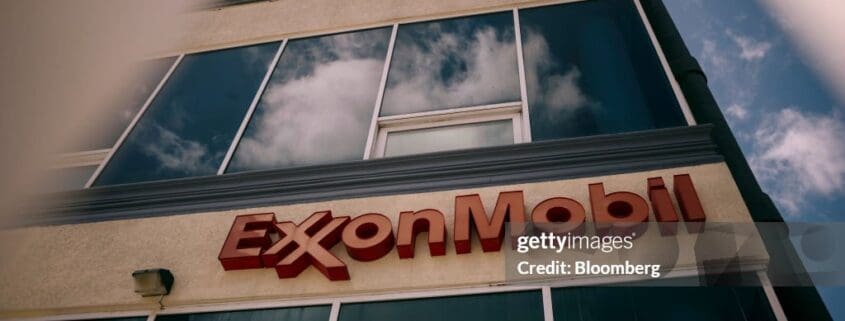Is ExxonMobil Operating At A $6 Billion Or $3.4 Billion “Loss” In Guyana?
Analysis By NAN Business Editor
News Americas, Georgetown, Guyana, Tues. Oct. 14, 2025: ExxonMobil’s Guyana President, Alistair Routledge on Monday claimed the company is “still operating in the red to the tune of around US$6 billion” in Guyana, as he retorted over to a question by three U.S. senators on the company’s tax breaks. So which number is closer to reality: $6 billion or $3.4 billion in losses?
The ExxonMobil Guyana offices at 86 Duke Street in Georgetown, Guyana. Photographer: Jose A. Alvarado Jr./Bloomberg via Getty Images
What Routledge Said
Speaking at Exxon’s Ogle, East Coast Demerara headquarters, Routledge told reporters that the NGO Oil and Gas Governance Network, (OGGN) may have misled U.S. senators about the company’s tax filings. He said that ExxonMobil Guyana is still operating with a negative cash flow of around six billion US dollars.
“We continue to be actually cash flow negative on an accumulative basis… we are probably still around six billion US dollars in negative cash flow as we look at the cumulative expenditures and cumulative revenues that we’ve seen from the Stabroek Block,” he told reporters.
Routledge asserted that in ExxonMobil Corporation’s 2023 and 2024 tax filings, there were no Guyanese tax credits included in either of those filings, “and you would recall that prior to 2023, we were not making profits here in Guyana, so there were no tax credits from that. Up until this point, there have been no Guyana tax credits used by ExxonMobil.”
The Alternative Figure: $3.4 Billion
But Exxon’s own Guyana website identifies a different figure: US$3.4 billion in red ink — even while acknowledging an accounting profit in 2024. According to Exxon’s 2024 financials:
Gross production rose sharply with the Prosperity FPSO, boosting revenue for all partners
Despite posting an accounting profit, the company said it remains “in the red” by US$3.4 billion
Exxon and its co-venturers have invested a cumulative US$55 billion in Guyana to date. This divergence begs the question: how can a company be both profitable on paper and yet claim to be billions in losses?
The Contractual Context
Under the 2016 Production Sharing Agreement (PSA), Exxon’s Guyana deal allows it to recover up to 75% of its share of oil revenue for cost recovery before profit payments begin. In practice, this means a large portion of early revenue goes to recovering the developer’s costs- capital, exploration, infrastructure – leaving little net profit early on.
Furthermore, financials for 2024 show:
Operating expenditures of GYD 477.6 billion
Depreciation/amortization at GYD 301.8 billion
Exploration, production, royalties also eat into margins
These mechanics help explain how Exxon could legitimately claim negative cash flow despite strong revenues.
Why It Matters for Guyana
The optics of a $6B loss vs $3.4B matters deeply for public trust, fiscal policy, and future licensing. Guyana has collected over US$6.2 billion in oil profits and royalties since 2020 – so when Exxon claims it’s in the red, critics say the narrative raises concerns about transparency and fairness. If Exxon can delay or reduce profit sharing through cost recovery claims, that changes the magnitude and timing of what Guyana as a partner actually realizes.
Bottom Line
Both $6 billion and $3.4 billion claims could contain grains of truth, depending on accounting methods, timing, amortization and recovery policies.
Routledge emphasized cash flow negativity and absence of Guyanese tax credits in filings.
Exxon’s public data insists on a lower loss figure despite profits.
The discrepancy boils down to methodology, timing, and cost recovery mechanics.
So, while the $6B figure commands headlines, the $3.4B estimate rooted in Exxon’s own reporting asks where did the almost three additional billion come from?. It’s really a question of how loss and profit are really defined.









Leave a Reply
Want to join the discussion?Feel free to contribute!